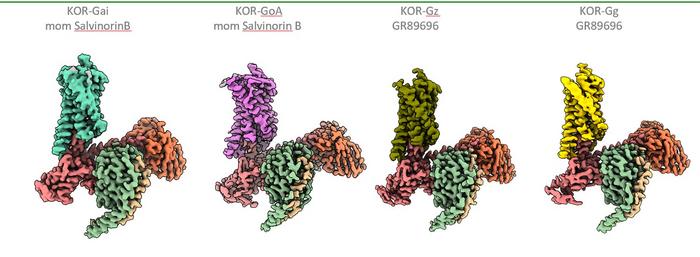Opioids remain the most potent and effective pain relievers in medicine, but they’re also among the most addictive drugs that can halt a person’s ability to breathe during an overdose — which can be deadly. Researchers have been racing to develop safer pain reliever drugs that target a specific opioid receptor, called the kappa opioid receptor, that is only found in the central nervous system and not elsewhere in the body, like other opioid receptors. Previous research suggests that such drugs may not lead to addiction or death due to overdose, but the currently known drugs that target these kappa opioid receptors have their own set of unacceptable side effects, including depression and psychosis.

Credit: University of Maryland School of Medicine
Opioids remain the most potent and effective pain relievers in medicine, but they’re also among the most addictive drugs that can halt a person’s ability to breathe during an overdose — which can be deadly. Researchers have been racing to develop safer pain reliever drugs that target a specific opioid receptor, called the kappa opioid receptor, that is only found in the central nervous system and not elsewhere in the body, like other opioid receptors. Previous research suggests that such drugs may not lead to addiction or death due to overdose, but the currently known drugs that target these kappa opioid receptors have their own set of unacceptable side effects, including depression and psychosis.
In one of the first steps towards eventually developing a new wave of kappa opioid receptor drugs without these side effects, researchers at the University of Maryland School of Medicine and Washington University have mapped the 3D structure of the central nervous system specific kappa opioid receptor and figured out how it differs from the other opioid receptors. In this new study, they discovered what instructs the kappa opioid receptor to change its shape, which uniquely binds to opioid drugs, akin to a lock fitting with a specific key.
They published their results in the May issue of Nature.
Aside from relieving pain, opioid receptors are also involved in everything from sensing taste and smell to digestion and breathing, as well as responding to many of the body’s hormones. The way that opioid receptors can influence so many functions around the body is by acting with one of seven cell activity proteins, known as G-alpha proteins, that each help to specialize the function they suppress in the cell.
“Knowing how these drugs interact with opioid receptors and having a clear view of this molecular snapshot is critical for allowing researchers to develop more effective pain-relieving drugs. This requires a drug that binds to the right type of opioid receptor, such as one in the central nervous system to reduce pain versus the ones that interact in the gut, causing side effects like constipation,” said study corresponding author Jonathan Fay, PhD, Assistant Professor of Biochemistry and Molecular Biology at UMSOM. “Additionally, these next generation medications will need to be designed with the appropriate kind of G-alpha protein in mind, as this will help to precisely target location and cell function by determining the specific shape of the opioid receptor — so the drug only reduces pain without affecting other body functions.”
The known kappa opioid receptor drugs do not produce the same euphoria as traditional opioid drugs, making these kappa opioid receptor drugs less likely to be addictive.
For the current study, the researchers used cryogenic electron microscopy in order to visualize the structure of the kappa opioid receptor. They first needed to flash freeze the receptors, which were bound to a hallucinogenic drug with one of two of the traditional G-alpha proteins. They then used a different drug to see how the kappa opioid receptor interacted with two other types of G-alpha proteins; one of these G-alpha proteins is found only in the central nervous system and the other is used to detect taste and smell.
Dr. Fay described the G-protein as shaped like a chainsaw with a handle and a ripcord. Each G-protein had a slightly different position of its chainsaw handle when bound to the kappa opioid receptor. This change in position played an active role in determining the shape of the kappa opioid receptor and thus what drug bound the best to it. These findings ultimately could have implications for how new drugs will be designed.
UMSOM Dean Mark T. Gladwin, MD, Vice President for Medical Affairs, University of Maryland, Baltimore, and the John Z. and Akiko K. Bowers Distinguished Professor, said, “Researchers face an enormous challenge in developing safer pain-reliever drugs since they will need to target both the correct opioid receptor as well as the appropriate G-alpha protein. Studies like these reinforce the mission of our new Kahlert Institute for Addiction Medicine, which aims to help develop this next generation of engineered small molecule drugs that are less addictive.
The research was supported by National Institutes of Health grants from the National Institute of General Medical Sciences (R35GM143061) and the National Institute of Neurological Disorders and Stroke (R01NS099341). The Titan X Pascal graphics card used for this research was donated by NVIDIA.
Journal
Nature
DOI
10.1038/s41586-023-06030-7
Method of Research
Experimental study
Subject of Research
Cells
Article Title
Ligand and G-protein selectivity in the κ-opioid receptor
Article Publication Date
3-May-2023




